INVESTIGATION, ANALYSIS, AND AUTHENTICATION OF HISTORIC WALLPAPER FRAGMENTS
FRANK S. WELSH
6 ANALYZING MATERIAL COMPOSITION AND EVALUATING ORIGINAL APPEARANCE
The fifth and most important category has two components: microanalysis to determine material composition and the evaluation of original colors and appearance. Fibers can be identified for paper or fabric wall coverings, as can pigments used to make paints and inks used to create patterns. It is also essential to analyze the nature of the binder that holds the paints together. There are extensive technology timelines available for dating paper pulping processes, the material components of wall coverings, and pigments and binding media. Among the most useful are books by Gettens and Stout (1966), Browning (1969), McCrone and Delly (1973), McCrone et al. (1979), Harley (1982), and the multi-volume Artists' Pigments series, by Feller (1986), Roy (1993), and FitzHugh (1997).
The stereomicroscope and the polarized light microscope (PLM) are critical tools used in the analytical process. On occasion, scanning electron microscopy and infrared spectroscopy are also employed. Identifying fibers or pigments not commercially available before specific dates provides critical benchmarks for the process of dating and authenticating papers. PLM is the most useful tool for analysis of these materials. An experienced microscopist can readily distinguish a number of components: paper fibers like cotton, flax, and wood; glue and starch binders; and paint pigments such as calcite, barytes, chrome yellow, and titanium dioxide. Examples from several projects demonstrate the usefulness of fiber analysis. Rice starch in association with flax fibers was identified in an early paper found at Kenmore (fig. 15). Starches were frequently incorporated into the papermaking process as binders (Sindall 1919), and they can be identified microscopically with polarized light because of specific optical characteristics, such as a unique black central cross. At Edgar Allan Poe National Historic Site (1842) in Philadelphia, cotton and flax fibers were used in a mid-century green ashlar-patterned wallpaper found intact over a doorway under many layers of paint in the first-floor Hall (fig. 16). Reprocessed rags were the main source for the cotton and flax fibers used in papermaking until ca. 1860, when wood pulp was gradually introduced and adopted by the paper-making industry. A combination of wood pulp, cotton, and/or flax is a variation that is more characteristic of the mid-19th century, when the paper-making industry began the shift between sources. Such variations, like that at the King of Prussia Inn in Pennsylvania, do occur. There, a light brown floral wallpaper was the first of many found on a 19th-century board partition at the 18th-century inn (fig. 17). The pattern style suggests a pre-1850s date, but fiber analysis showed the presence of wood pulp fibers in association with flax, indicating that the paper is post-1860 (figs. 18, 19).
Identifying pigments whose initial dates of manufacture are known eliminates some questions of authentication. The most notable early-19th-century pigments are chrome yellow and barytes, which were found in wallpapers at Gunston Hall and Kenmore and in the collections at Colonial Williamsburg. Removal of overdoor pediments in a principal first-floor room with original board walls at Gunston Hall revealed many very small wallpaper fragments showing a partial pattern block-printed in red and yellow
Fig. 15.
Starches can be identified microscopically with polarized light because of their unique black central cross and other optical characteristics. Analysis of an early paper found at Kenmore revealed rice starch in association with flax fibers (250x).
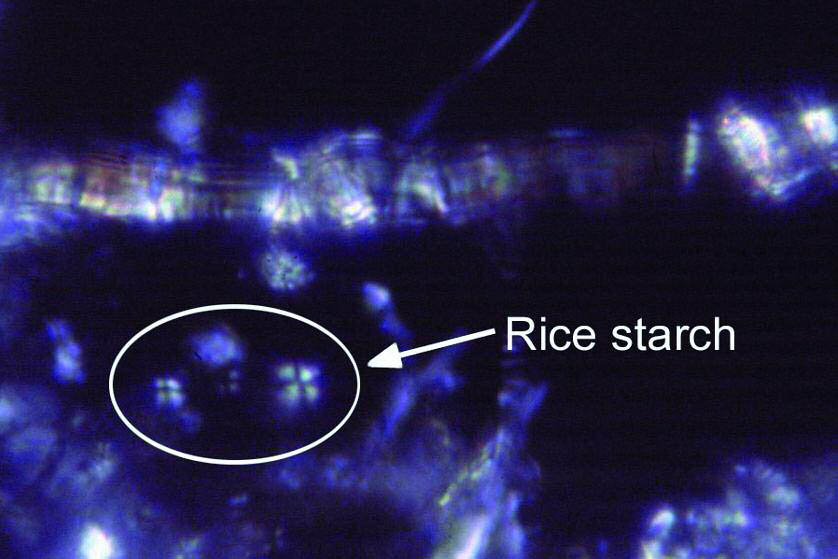 |
Fig. 16.
These two paper fibers, viewed with crossed polars, are from the original rag wallpaper discovered under many paint layers in the first-floor Hall of the Edgar Allan Poe House (1842) in Philadelphia, Pennsylvania. The thick, rounded fiber is flax (linen) and exhibits characteristic transverse nodes that look like Xs and Vs. The thin fiber that looks like a flat, twisted ribbon is cotton (100x).
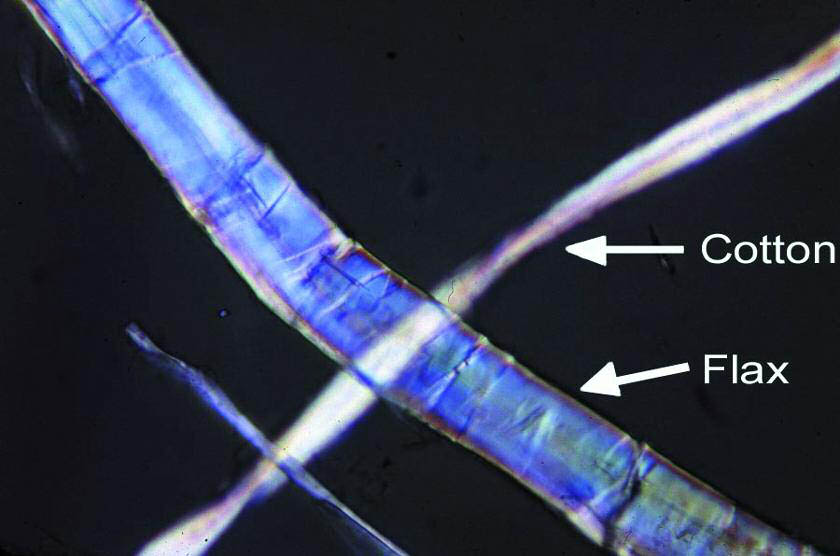 |
Fig. 17.
This light brown floral wallpaper was the first of many found on a 19th-century board partition at the 18th-century King of Prussia Inn in Pennsylvania. Fiber analysis disclosed wood pulp fibers in association with flax, a finding indicating that the paper was made after 1860 (see figs. 18, 19).
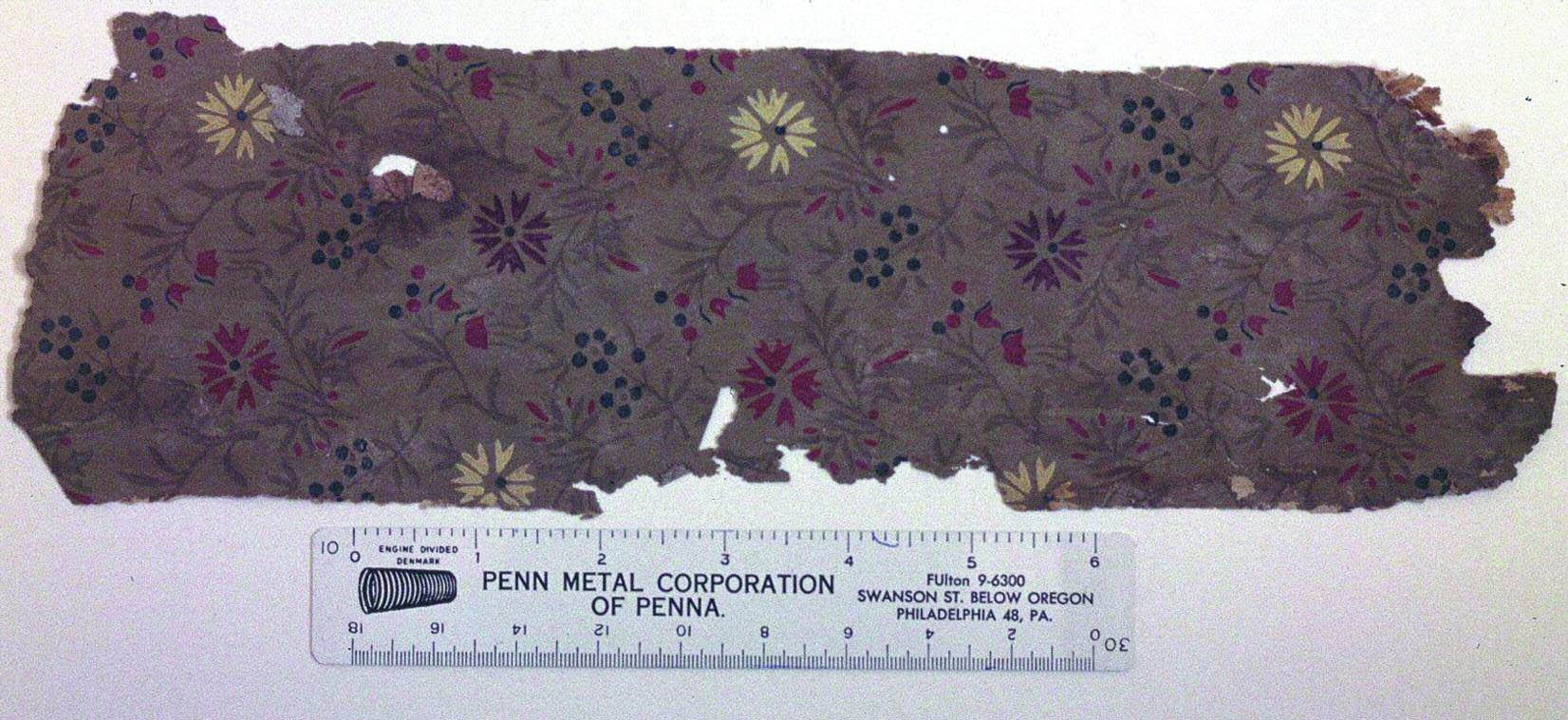 |
Fig. 18.
When viewed with crossed polars, fibers from the floral wallpaper at the King of Prussia Inn (fig. 17) show a mixture of flax and both coniferous and nonconiferous wood fibers. The coniferous wood fiber (arrow) is best characterized by the long, flat, tapering fiber with a single row of bordered pits seen as a series of black crosses (100x).
 |
Fig. 19.
Flax fibers from a paper at the King of Prussia Inn (fig. 17) are indicated by the transverse nodes, and the nonconiferous wood fiber (arrow) is characterized by the large baggy cell with many transverse rows of pits (100x).
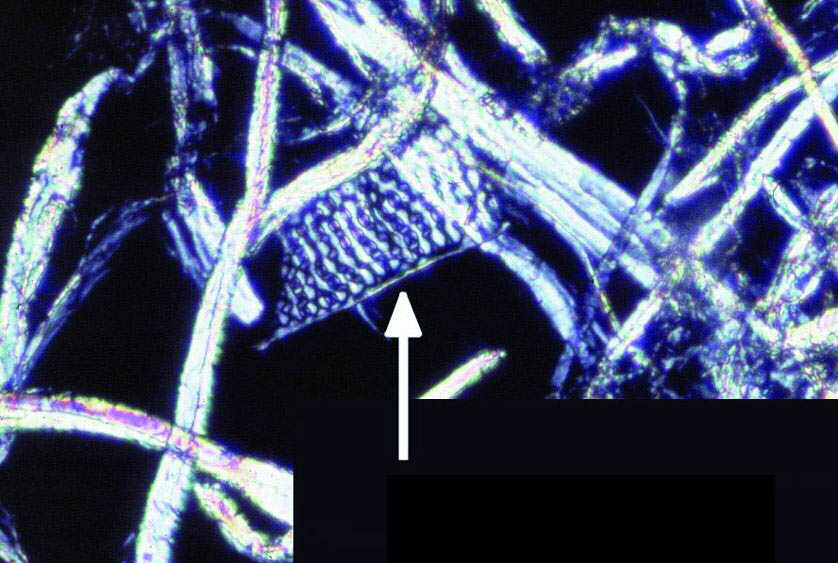 |
on rag (cotton and flax) paper (fig. 20). PLM analysis of the yellow distemper paint showed that it was tinted with chrome yellow, a pigment not available commercially until the early 19th century, consequently proving that the wallpaper was not original (fig. 21). Microanalysis of a medium gray distemper paint from a gray-and-black striped wallpaper fragment found on the edge of a doorway pilaster at Kenmore identified barytes as one of the constituent pigments (fig. 22). Barite (barium sulfate) is a naturally occurring mineral that was not widely used as a pigment, called barytes, until the early 1800s. Identification of the pigment barytes in the paint at Kenmore helped date the wallpaper fragment to the early 19th century rather than as an original 18th-century paper (figs. 23, 24).
Another pigment with a proven chronology is titanium dioxide (white), one of the most widely used pigments manufactured in the 20th century. The anatase form was available by 1920, but the rutile form was not used until the early 1940s (McCrone 1997). At Belle Meade, a mid-1800s plantation house in Nashville, Tennessee, the anatase form of titanium dioxide appeared in both the light blue ground paint and white pattern paint of a second-floor bedroom frieze wallpaper, proving that the paper was made in the 20th century.
Fig. 20.
At Gunston Hall (1755), the removal of the over-door pediments in a principal first-floor room with original board walls revealed many wallpaper fragments that showed a partial pattern block-printed in red and yellow on rag (cotton and flax) paper.
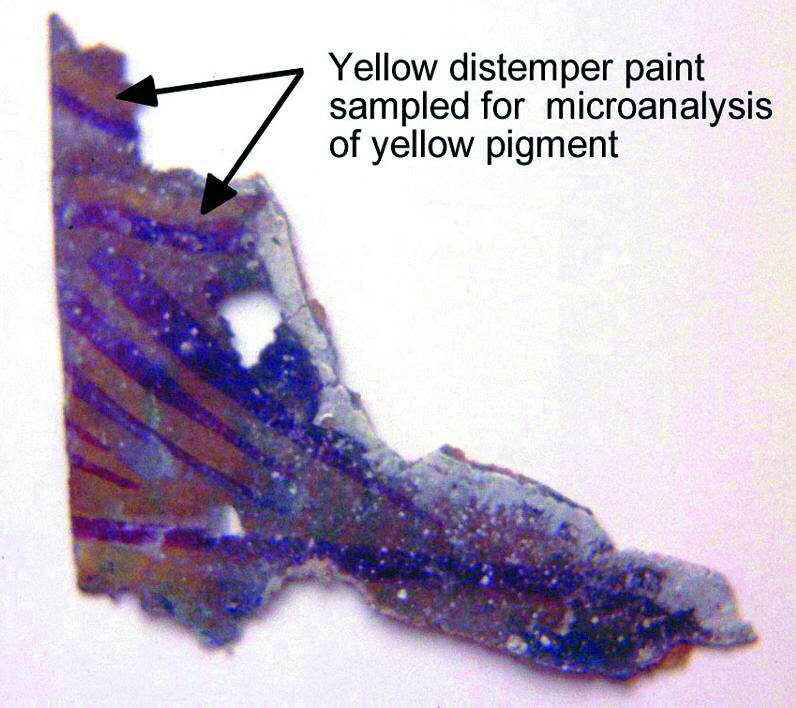 |
Fig. 21.
These are chrome yellow pigment particles from the yellow distemper paint in the Gunston Hall wallpaper fragment (fig. 20). The chrome yellow exhibits characteristic rod or needle shapes (arrows) and a high refractive index (250x).
 |
Fig. 22.
This gray-and-black striped wallpaper fragment was found on the edge of the removed doorway pilaster in the Hall at Kenmore (1775) (fig. 4). Microanalysis of the medium gray distemper paints identified barytes, not used before the early 19th century, as one of the constituent pigments (figs. 23 and 24) (15x).
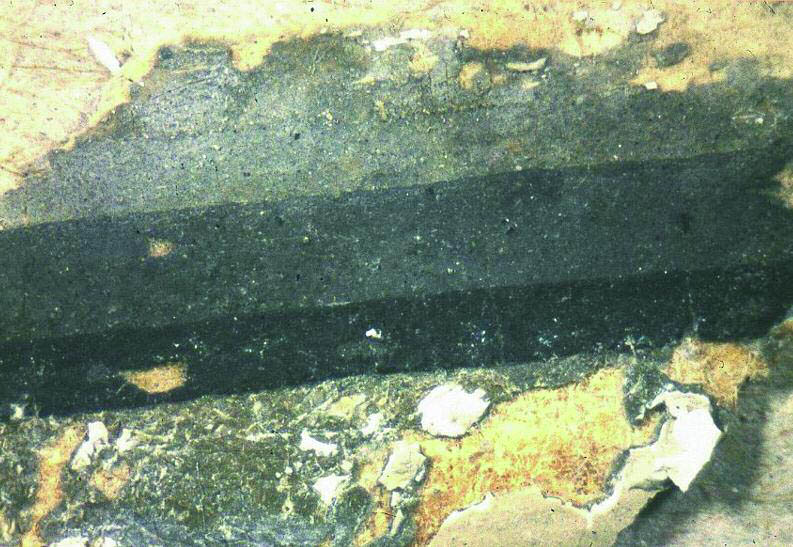 |
Fig. 23.
Barytes pigment particle (circled) from the Kenmore gray-and-black striped wallpaper fragment (fig. 22) is visible when viewed in crossed polars. Here it is near extinction (see fig. 24) (250x).
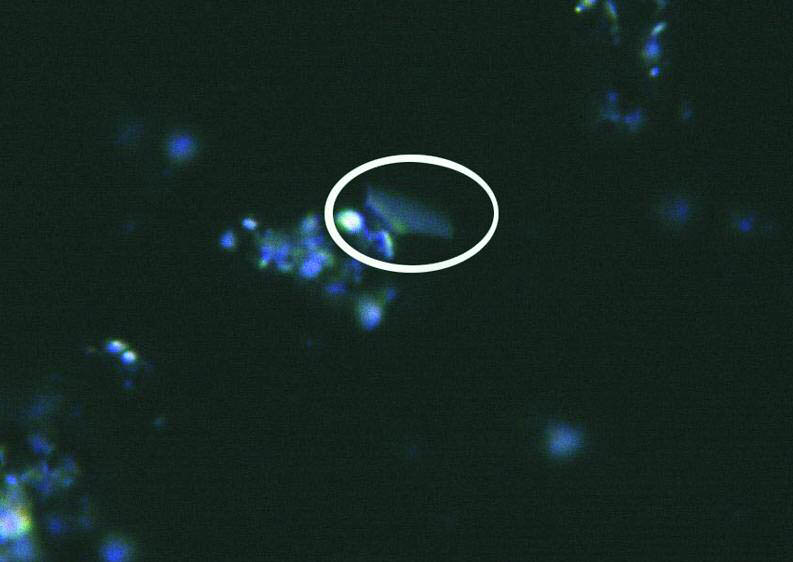 |
Fig. 24.
By rotating the microscope stage, the barytes pigment particle (circled) from the Kenmore paper is seen at the strongest contrast (250x).
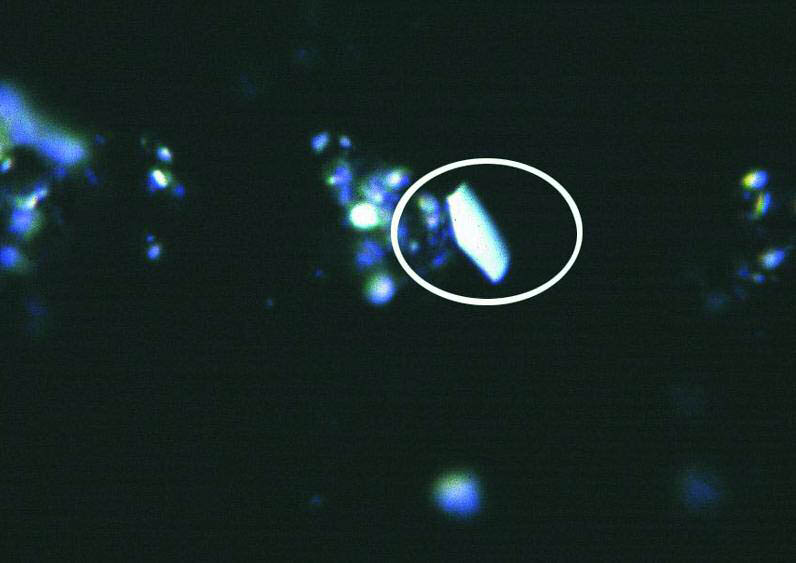 |
Sometimes, though, dating pigments is more fluid than fixed. The entry on chrome yellow in Gettens and Stout (1966, originally published in 1942), one of the most widely used references for pigment information, states that the pigment was known in 1809 but was not in commercial production until 1818. However, Fodera et al. (1997, 106–7) cite an 1812 advertisement for chrome yellow in Baltimore. Research continues to refine our understanding of the history of pigment and fiber production and availability. Publication of that research is a valuable component of materials analysis.
Other materials identified under the microscope also offer clues to a paper's history. One of these is shellac, a varnish coating used in the mid-to-late 19th and early 20th century to protect papers and make them washable, especially those used in bathrooms (fig. 25; see also fig. 6). A recipe for “washable wallpaper varnish” appears in McIntosh (1911, 394): “Shellac or stick lac 30 lb., borax 30 lb., water 20 gallons. Boil til dissolved, filter; when applied on wallpaper with a smooth brush it dries with a fine gloss. Two coats are given.” Shellac generally yellows with age, adding to the challenge of evaluating colors. Other culprits are dirt and grime, which accumulate on wallpaper surfaces and cause severe discoloration.
Dirt and grime present a special problem if the wallpaper is a candidate for reproduction. Before embarking on the reproduction process, a thorough examination of the fragment and a search for protected areas are necessary to visually match pattern colors as closely as possible. The 18th-century English floral wallpaper from the study collection at Colonial Williamsburg Foundation discussed in section 1 (see fig. 2) illustrates this point. Another example is from a bathroom in an early-20th-century suburban Philadelphia residence where the original 1939 Sanitas was discolored by accumulation of nicotine (see fig. 14), but cleaning a tiny portion of paper preserved under a light fixture revealed the original color.
For a wall covering such as plain painted canvas, a color match of the fabric itself may not be essential; however, the original sample can be analyzed for material composition and thread count. This information
Fig. 25.
This imitation tile paper from a bathroom in a late-19th-century house in Jim Thorpe, Pennsylvania, is coated, for protection, with a very thin layer of shellac. Sample courtesy of Gail Winkler
 |
enables the selection of replacement canvas of the same fabric and texture, if restoration of any missing historic material is desired. This process was followed at Oldfields in Indianapolis, where 1930s wall and ceiling canvas had been removed during later renovations of certain rooms. The results of the microanalysis of surviving canvas samples were presented to the architect to specify the proper grade of canvas for use in the restoration.
|










